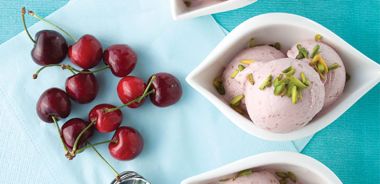Cherry Frozen Yoghurt

Serves 6
Most store-bought frozen yoghurt is loaded with added sugars, artificial flavours and other undesirables. Thankfully, homemade creamy fro-yo sans ice cream maker is far from a high-flying kitchen feat. Simply blend together tangy Greek yoghurt with any seasonal fruit, place in the freezer and mix regularly to prevent ice crystals from forming. A perfect way to beat the summer heat. Chopped nuts provide nice textural contrast.
2 cups (500 ml) plain 2% Greek yoghurt, divided
1 1/2 cups (350 ml) sweet cherries, pitted
1 1/2 Tbsp (30 ml) honey
1 tsp (5 ml) almond extract
1 tsp (5 ml) lemon zest
1/3 cup (80 ml) chopped unsalted pistachios (optional)
1. Place 1 cup (250 mL) yoghurt, cherries, honey, almond extract and lemon zest in blender or food processor container and blend until smooth.
2. In large bowl, stir remaining yoghurt into mixture.
3. Pour mixture into flat airtight container and freeze for about 45 minutes.
4. Remove container from freezer, remove cover and, using whisk or fork, stir in icy bits from edges and mix with softer centre until smooth.
5. Place in freezer for another 30 minutes, covered.
6. Repeat this process every 30 minutes for up to 2 hours until completely creamy and soft. Make sure to whip until smooth each time before putting container back into freezer. (It’s a good idea to set a timer so you don’t forget and let the mixture freeze solid.)
7. Serve topped with pistachios, if using.
Each serving contains: 557 kilojoules; 8 g protein; 5 g total fat (1 g sat. fat, 0 g trans fat); 17 g total carbohydrates (14 g sugars, 2 g fibre); 0 mg salt
Extra credit
Cherries are a good source of vitamin C, which may help reduce the risk of hypertension, according to a recent American Journal of Clinical Nutrition study.
source: "The Big Chill", alive Australia #14, Summer 2013





